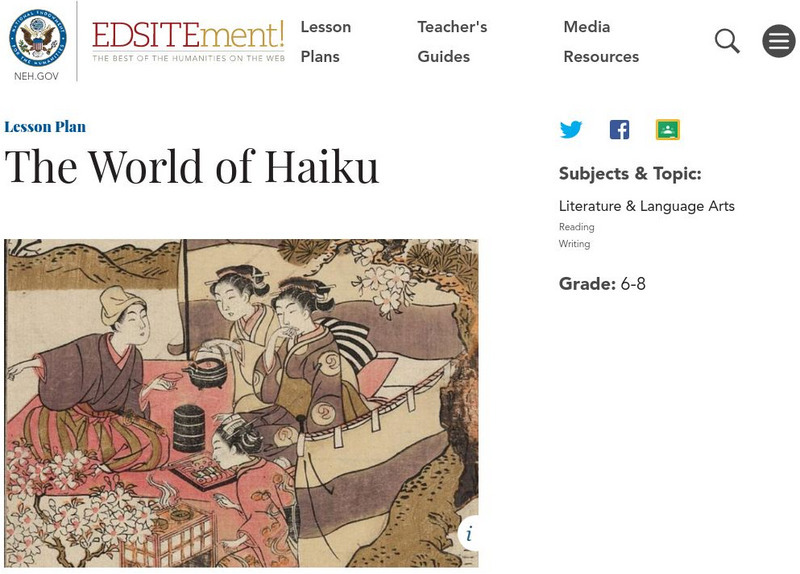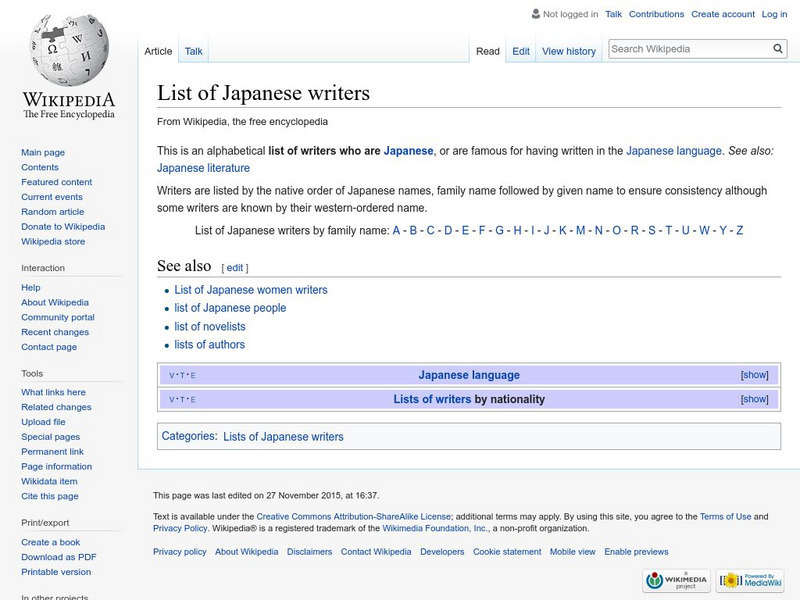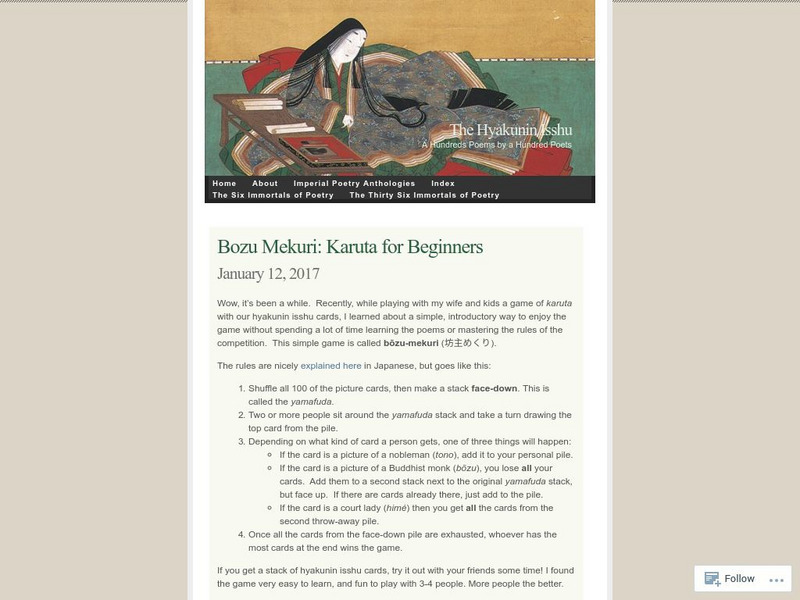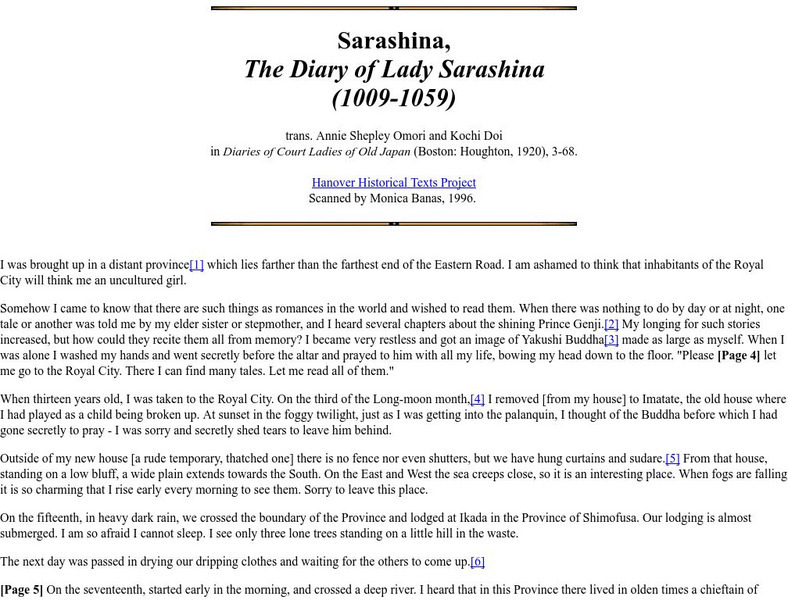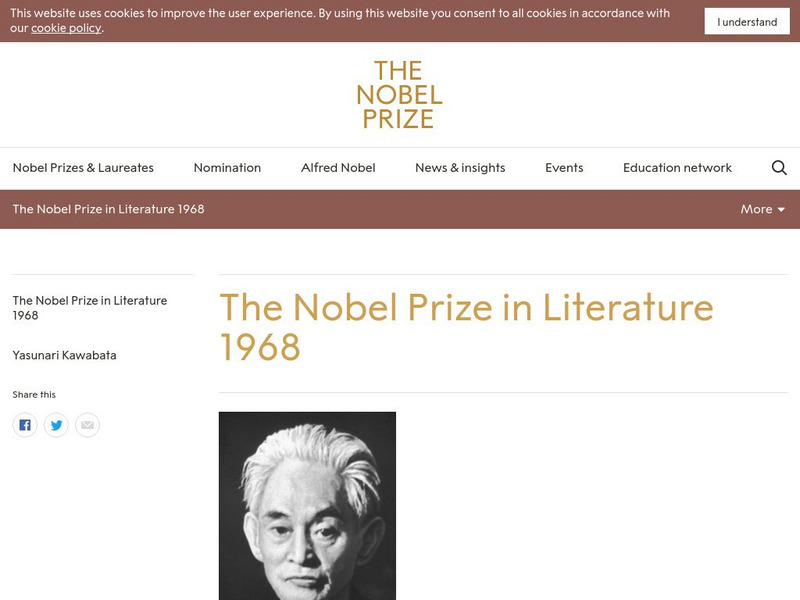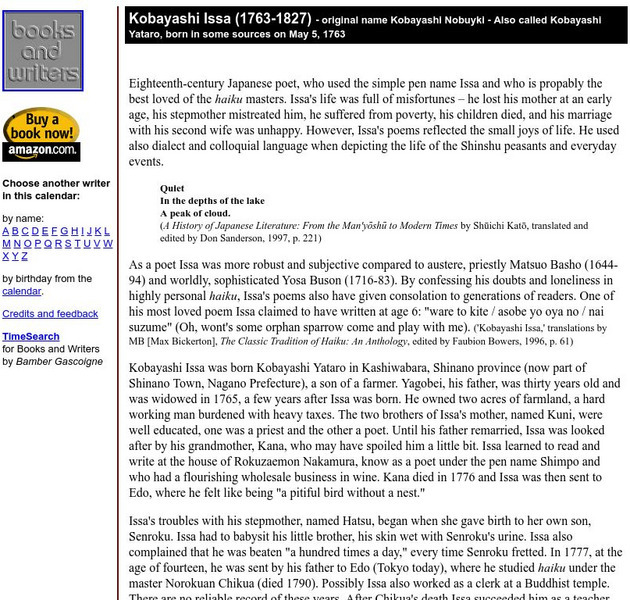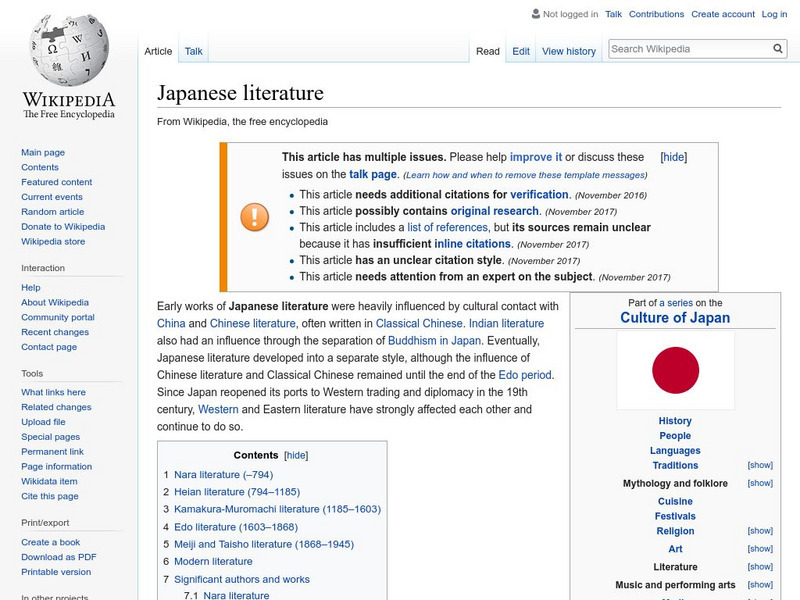Hi, what do you want to do?
National Endowment for the Humanities
Hamlet Meets Chushingura: Traditions of the Revenge Tragedy
Students read texts, view film and video and conduct research in an analysis and comparison of Shakespeare's "Hamlet" and the Kabuki piece "Chushingura". They focus their analysis on the theme of revenge.
Indiana University
Literature of Asia and the Middle East: "A Sound of Hammering" by Dazai Osamu
Dazai Osamu’s short story, “A Sound of Hammering” is the focus of a three-day investigation of modern Japanese literature and life in post-World War II Japan. The events in Osamu’s story mirror those in his own life, and give a...
Japan Society
The “I” Novels in the Context of Early 20th-Century Japan
Although this lesson plan covers the rather obscure topic of the Japanese "I-novel", it also includes a great deal of historical information and material for an in-depth discussion of universal literary concepts. Specifically, young...
Indiana University
British Literature Restoration Unit: The Pillow Book – Sei Shonagon
First drafted in the year 996, The Pillow Book contains reflections of those met by a lady-in-waiting in the Japanese court. A brief summary, historical context, and discussion questions are provided on the first two pages. Then, two...
Curated OER
Haiku and Beyond: Exploring Genres of Japanese Literature
Fourth graders compare and contrast the literature of Japan as they study the culture, history and geography of the island nation. They read various genres of literature, describe geographic and landform features of Japan, and find...
Curated OER
???The Hell of Mirrors??? by Edogawa Rampo
Students read and analyze the story "The Hell of Mirrors," by Edogawa Rampo. They watch a video excerpt, answer discussion questions, construct a periscope, complete handouts, define key vocabulary terms, take a quiz, and write a book...
Curated OER
Creating Scrolls Based on the illustrated TALE OF GENJI
Young scholars identify formal elements that characterize the scroll, work in a variety of media, from traditional to digital, to create their own scrolls, work into digital printout with at least two media, and engage in meaningful...
Curated OER
Exploring Japan Through Learning Centers
Learners explore the Japanese culture and literature through various learning centers. They compare and contrast story details in two stories and complete a Venn diagram. After comparing the stories, they rotate to different centers and...
Curated OER
Encounter with a Skull (Tae dokuro, 1890)
Young scholars read and analyze a short story by Koda Rohan. They conduct research, read and discuss a biography of the author, identify examples of Japanese and Buddhist symbolism in the story, and write an original story.
Curated OER
"In a Grove" and "Rashomon" by Akutagawa
Students read and analyze the short stories, "In a Grove," and "Rashomon," by Akutagawa. They discuss the samurai warrior culture, watch a short video, take a quiz, participate in whole-group discussions, identify similes and metaphors,...
National Endowment for the Humanities
Neh: Edsit Ement: The World of Haiku
A productive, technologically relevant site that provides a lesson plan on the Japanese Haiku. Complete with educational objectives and extensive student-centered lesson development.
Wikimedia
Wikipedia: List of Japanese Writers
This is a sizeable list of Japanese writers and poets, organized alphabetically. It includes many 20th century and contemporary people, as well as a scattering of writers from earlier periods. Some authors have extensive articles; others...
Other
Presents From the Dead: Analysis of Haruki's Works
The author of this critical review analyzes the role of the narrator, "I," in Haruki's novels, discussing whether the "I" psychologically plays a mother or father role. This site is a translation of the original critique.
Other
A Brief Biography of Isikawa Jun
Included in this biography is an explanation of the political influences which affected Jun's writing, as well as some discussion of how he influenced other Japanese writers like Abe.
Other
Interview With Abe Neri
This is quite an interesting interview with the daughter of the famous Japanese writer, Abe Kobo. It is a translation, so the language doesn't flow as smoothly as it would in the original, but Neri talks about a lot of the influences in...
Other
Univ. Of Virginia: Ogura Hyakunin Isshu: 100 Poems by 100 Poets
By clicking through this site, the viewer may see these 100 poems in English, in Japanese characters or in Japanese (using the English alphabet). Some explanation of the poems' sources is also given.
Hanover College
The Diary of Lady Sarashina
The complete diary of one of the "Court Ladies" at the Japanese Imperial Court during the early 11th century. Provides many examples of Japanese poetry from the period.
Nobel Media AB
The Nobel Prize: The Nobel Prize in Literature 1968
This website from The Nobel Foundation gives the 1968 winner of the Nobel Prize in Literature -- Yasunari Kawabata -- is organized into the following sections: "Presentation Speech," "Biography," "Nobel Lecture," "Swedish Nobel Stamps,"...
John F. Kennedy Center
The Kennedy Center: Oceans: A Sensory Haiku
In this lesson plan, students use the ocean and their five senses as inspirations to create their own unique haikus. Lesson provides assessment criteria and a list of sources.
University of Wisconsin
Kitchen: "Beauty That Seems to Infuse Itself Into The"
This is a paper by a college student majoring in Japanese. In it, she analyses Banana Yoshimoto's novel, "Kitchen," and the differences she finds between the original and an English translation.
Authors Calendar
Author's Calendar: Kirjasto: Kobayashi Issa
This site provides both biographical information and some analysis of Issa's work. Links to significant names.
Authors Calendar
Author's Calendar: Yasunari Kawabata (1899 1972)
This site presents a biography of Yasunari Kawabata, who was the first Japanese novelist to win the Nobel prize for literature. The biography highlights the poetic nature of Kawabata's fiction.
Wikimedia
Wikipedia: Japanese Literature
Wikipedia provides detailed information on the history, forms, and authors of Japanese literature. Includes external links and hyperlinked terms.
University of Arizona
The Milky Way Train: Celebrating Kenji Miyazawa
This site presents a synopsis of Kenji Miyazawa's novel, "The Milky Way Train," focusing on the author's interest in astronomy and how he weaves that into his story.















